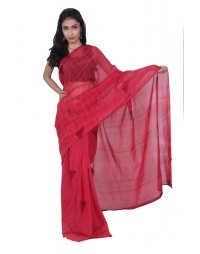Fabric used for sarees

Saree is an unstitched piece of traditional wear. It varies from four to nine yards according to the women height. It gives elegant and fashionable look. It is not only worn in India, but prefered around the world. It simplifies women beauty of any age. For ravishing and stylish look matching blouse and petticoat is necessary.
India’s traditional and cultural background gives vivid colorful sarees according to geographical locations. Anyone can choose sarees on basis of designs, draping styles; even anyone can opt for fabric quality used, and blocks printed patterns. India is a country that gives traditional Cotton Fabric Wholesalers like chhipaprints in Jaipur, whose designers give the old traditional style into a new fashionable look keeping the traditional values at top priority, like cotton printed suits from Chhipaprints.
The Rajasthan, which is known around the world for the amazing history and in that, Jaipur a famous tourist place gives you to buy the traditional stylish block printed sarees and Bandhani sarees for any occasion. You will also get the traditional sarees such as Patola, Chikan, Pochampalli, Chanderi, Jamdani, Silk¸ Tussar, Banarasi, Mysore Silk¸ Mundum Neriyathum and several others which manufactured in states of India.
The Indian sarees are worldwide accepted branded clothing accessory. Let’s discuss about the classic fabrics used for such elegant and dimensional clothing –
The west of India uses silk and cotton fabric for creating tie-die, patola, ikkat, and block-printed sarees. The artisans of Kota use fine cotton mixed with single-filament silk thread. For inexpensive traditional sarees, low quality of silk fabric use. These sarees weave in such a manner to give comfort for people living in the India’s hot region. The Raksha Bandhan saree from Gujarat made with silk satin fabric.
The northern Indian artisans use wool, mulberry silk and cotton for ethnic sarees.
The eastern region of India is a hub for three natural fabrics includes wild silk, mulberry silk and cotton with a combination of vivid indigenous fabric. The wild silk produces rough fabric as they have irregular filaments. The Bengali cotton gives distinct crepe like appearance that cultivated from mechanical spinning to give expensive sarees.
The ‘tant’ sarees from Bengal made of good cotton. These sarees are famous for their classic designs and ethnicity. The tangail Jamdani, made from wild silk called tussar has good demand all over the country. The ‘Garud sarees’ often wear by Bengali women, especially for Puja. These sarees fabricated with mulberry or tussar.
The eighteen and nineteen century of Bihar artisans use the cotton and silk appliqués for zardozi embroideries. The kanta sarees embodied with mulberry and tussar silk. Gotta and traditional sarees of Bihar made from red silk.
Bihar is the tussar silk manufacturing state of India. Here five types of tussar silk fabric are woven and four types are exported all over India.
West Bengal famous for Khadi sarees, these sarees gives more texture, appearance as they are hand-reeled and hand-woven.
The Indian women emphasized more with the Banarasi saree created extensively from pure silk and satin.
It is the work of our historic artisans from which we are enjoying the traditional quality of sarees. It is the amalgamated fabric with which we are getting inexpensive, yet durable and qualified dress material and traditional sarees. It is the artisan’s mental ability to improve the limitations of real fabric. Thus rise to give intricate artistic quality designs.
